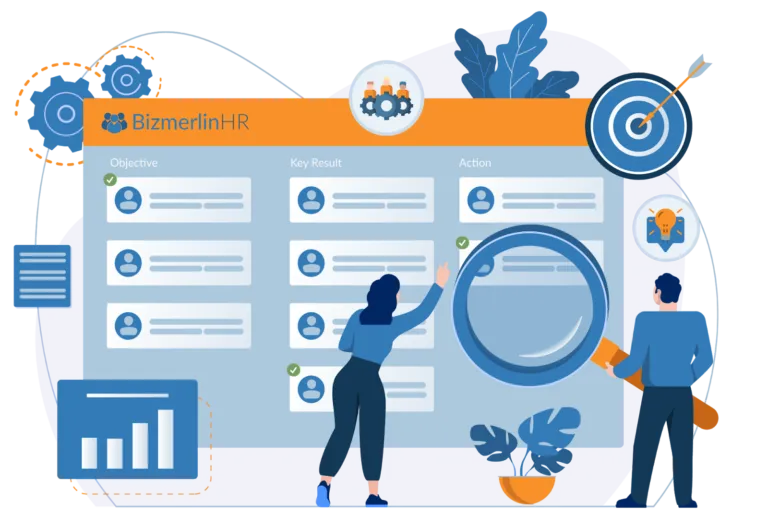ClayHR Explores the Human Side of AI in Hiring — Discover, Debate & Learn. Register Now

A management best practice sees managers and employees setting goals and tracking performance in a collaborative environment. The quantity and quality of employee performance require goals and the means to measure progress. So, managers and employees must align their vision, plan, and strategy for achievement.
Most organizations have moved beyond setting arbitrary goals and commanding achievement and efficiency. Organizations realize that managers should coach and mentor employees toward their win. Managers and employees must partner in setting, tracking, and reaching goals they have set together.
Here are 5 simple and actionable mechanisms to help your organization build that culture of using their preferred methodology (goals vs. OKRs, etc.) to achieve the desired outcomes.
To compare Goals, OKRs, MBOs, etc., you can also check this article out.
Everyone in the work unit – division, department, or team – should work on a playing field leveled with commonly understood definitions. Goals, objectives, metrics, OKRs, and other organizational buzzwords need clarity. They are not synonyms, and we should not use them synonymously.

For example:
Goals offer short statements of outcomes desired over the long term.
Objectives present actionable targets that require completion in the short term if the organization is to achieve its Goals. Metrics measure the quantitative performance of people and projects at multiple points.
Employees want to see the Big Picture. They want to visualize how their action impacts customers and communities. Workers enjoy being part of an organization’s strategy, and they want to picture where they fit into the short- and long-term plans.

Organizational performance increases when employees sense their work changes things. Workers appreciate knowing how their specific tasks benefit the organization and its customers. Employees understand how much they depend on others and how much others rely on them.
Each employee works towards specific goals. Those individual journeys must integrate and align with the organization’s more general objectives. Metrics count quantitative progress toward the achievement of goals. But metrics can also report qualitative integration and alignment.

Over time, projects will change, goals will shift, and teams will lose and gain membership. It takes real-time measures to sustain and scale performance. But individual and team performances must always support organization objectives.
Management and staff must understand what and when metrics are measured. For example, KPIs (Key Performance Indicators) work well in some organizations. Typically, management reviews KPIs monthly, quarterly, or annually. The entire organization can review OKRs (Objective & Key Results) monthly or quarterly. OKRs focus on 3 to 5 objectives while 3 to 5 key results support each of those objectives.

Many organizations support SMART Goals. SMART Goals must start out as, and then remain Specific, Measurable, Achievable, Relevant, and Timely. Each quality guides and scores individual and team performance.
Many thanks to OKR guru Nikhil Maini for providing this perspective: “I recommend review and learn regularly rather than measure regularly… focus must be what people are learning and what needs change. Measurement is a hygiene factor.”
Management once measured performance based on observation and memory. This approach risks an institutionalized individual and maybe group biased. Software developments have created better ways to track and share employee performance. The software can report hours worked, absenteeism, and other daily events. These dashboards provide the data needed for better decisions.

However, these systems can also track machine usage, internet activity, calls, etc. Organizations can customize the tracking to their operations and objectives. For instance, ClayHR’s Goal Management tool helps you collaborate to boost employee satisfaction, engagement, results, and productivity with intuitive and interactive SMART goal tracking.
As per Nikhil Maini, data and information is good but it’s a means to an end…not the end itself. Hence, we need to be careful of losing the human interaction. Goal setting and execution, using any framework, is a social process. Human interaction is key.
As organizations leverage project time clock software to track various metrics, it's essential to remember that the human element plays a pivotal role in goal setting and execution. The social aspect of collaboration, communication, and interaction among employees cannot be understated. While data and technology provide valuable insights, organizations must prioritize human interaction to foster a positive work culture and drive employee engagement, satisfaction, and productivity.
Organizations must make better decisions to compete in the economy emerging from the impact of sequential pandemics. They need more data relevant to their short-term tasks and long-term objectives.
Management needs complete and current information on workforce demographics. Managers should have access to the pulse of operations and active participation of individuals and teams in meeting the goals that will deliver the organization’s objectives.
Employees perform better when they have access to reliable data on their engagement and performance. And they perform eagerly when they have had a voice in framing goals, objectives, and metrics.